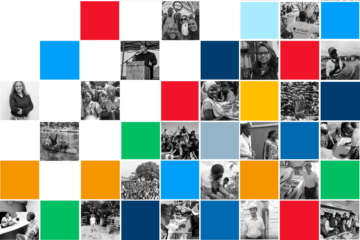Access Interview: Friederike Möllers, Head of Business Department at AccessHolding

By Ivana Mitrovic
Friederike Möllers is Head of Business Department at AccessHolding. After joining AccessHolding in 2009, Friederike worked as Credit Consultant in AccessBank Tanzania, Head of Micro Credits in AccessBank Liberia, Credit Manager and deputy CEO in AccèsBanque Madagascar and as Interim CEO in AccessBank Liberia. She also served on the Board of Directors of AccèsBanque Madagascar for five years. Prior her position as Head of Business department at Access Microfinance Holding, she set up and managed AccessCampus, the Holding’s network wide learning centre for high potential employees.
Banking will always remain a business of trust – and for trust to grow it takes a relation between people.
AccessHolding has made a significant step forward and towards digitalisation in the past few years. As a person who facilitates and steers the process on a network level, can you tell us how do you see it fits AccessHolding’s overall mission and more specifically its strategy?
The Holding’s mission has always been and continues to be the delivery of fast and simple financial products and services to micro and small business entrepreneurs and their families.
When we moved into the markets more than 12 years ago, entering a banking hall was a big step for many of our customers. The general perception was that banking was for affluent people and financial services something that is only available to you if you already show a certain standard of living and sufficient collateral. This has changed dramatically and we, along with other similar players, were able to prove that providing financing options to the previously underserved, is not only a much-needed tool in supporting predominantly informal economies, but can also be a viable business approach.
I remember times when in Liberia we had only one phone number for ten ladies selling at the same market place and we accepted ID documents that were issued by local churches. Much has happened since then. The markets we operate in have seen a significant increase in access to digital technologies, such as mobile phones and the internet, and some level of formalization of the local economies. Clients have grown more tech-savvy and see the use of these technologies as an increase in convenience to manage their daily chores and livelihoods. At the same time, the outreach to more rural areas has always been a challenge in the Microfinance world, due to the relatively high cost of establishing a branch infrastructure.
The recent technological advancements create immense opportunities for our clients and our banks. As such, we have developed a digitalization strategy which focuses on three pillars: creating access to financial services outside of the branch infrastructure via alternative delivery channels, digitizing internal processes and creating efficiencies in the business model which are also benefiting the customer and finally, the increased collection and analysis of data to improve business decisions.
Can you please tell us more about the pillars of AccessHolding’s digitalization strategy?
With our customers in mind before anything else, it was obvious that we need to tackle the first pillar as a priority. Since 2020 all our network banks have at least one digital channel up and running, allowing our customers to reach the bank outside of the branch building and outside of the normal opening hours. The type of channel varies per institution; some are social media channels that are linked to the bank (Facebook in Madagascar), collaborations with MNOs such as Orange and MTN (Liberia, Madagascar and Rwanda) or the roll-out of the Holding’s own electronic wallet, our ‘eTumba’ in Zambia. The basic functionality offered on these channels are payment transactions from wallet to bank account and vice versa. Some of our banks already offer additional products like payments via QR code or bill payment functionalities. The enhancements of the channels and the provision of banking products and services such as savings plans, loans and other tools that help the entrepreneur manage their daily financials, will be the goal for the months to come.
As for the second pillar, the digitization of internal processes, we have so far implemented two projects that are directly linked to the loan cycle. One is the scoring of repeat clients, whereby eligible clients are run through an algorithm based on historic data and loans are granted without any additional visit to the client, usually with a one-day delay between application and disbursement. The feedback from clients has been overwhelming as they really appreciate the trust that is granted to them based on the loyalty they have shown to the bank. The second project is the digital collection of business data from the client via a tablet-based assessment form. The underlying idea here was to tackle various challenges at once: we were keen on collecting more data that can be used for future analysis and reference models (previously everything was on pen-and-paper and as such, tedious to analyse), we saw a need to reduce operational risk by built-in crosschecks of the clients’ financial situation and we wanted to smoothen the process of shuffling paper back and forth between Front and Back Office functions. This project is now fully live in Nigeria and roughly 40% of all Micro loans are assessed via this new tool after only one month since implementation.
The third pillar is somewhat embedded in the first two, as for every decision to take on a project we use big data to support the business case and oftentimes we integrate business decision-making into the new tools (see examples above such as Scoring).
So, back to your question, the digitalization strategy of the Holding is just a continuation of our desire to deliver fast and simple financial solutions to our target groups – just making increasingly more use of available and customer-oriented technology.
Overall, we have seen our network-wide KPI [measuring the % of out of branch transactions] increase from 33% at the end of 2018 to 52% at the end of 2019 and to 71% at the end of last year.
Can you please tell us how do you assess the work done so far? Since you have already set certain indicators to measure the progress, can you share with us how the digitalisation of AccessHolding looks like in numbers?
Certainly. As for the first pillar of the strategy, the extension of digital channels to our clients, we established a KPI that measures the % of transactions that happen outside of our branches – and we did indeed see tremendous uptake here! Numbers vary by bank also based on when they first introduced digital channels (CREDO started as early as 2015 and Liberia and Rwanda just started in 2020), how many channels they have up and running, and how the general digital literacy of our clients is (Liberia is more difficult than Rwanda for example). Overall, we have seen our network-wide KPI increase from 33% at the end of 2018 to 52% at the end of 2019 and to 71% at the end of last year. It is worth mentioning that the uptake was especially good last year, as many clients truly appreciated the ability to access their funds even when banks were under lockdown conditions.
For the second pillar, let me share some data of our Scoring portfolios. The share of scored loans in our Micro portfolios was 25% by the end of 2019 and increased to 30% for 2020. Given the difficulties encountered last year this is a very good result. We also see that the average processing time for scored loans is 40% less than for traditionally assessed loans and the PAR30 figure for the scored portfolio is 50% below the one for the traditionally assessed loans. So, in a nutshell, we can now offer faster and more convenient products to our clients, which at the same time are more cost-efficient to the bank, as we reduce operational costs and credit risk.
All this sounds very impressive! Can you maybe disclose some of the plans for the future? What can we expect to see in the following period that will further strengthen the position of AccessHolding’s institutions as finance market disruptors?
As already mentioned above, one of the most important goals is to extend the product offer on our digital channels. We expect that within the next 12-18 months our clients will basically be able to access any service that they have in the branches on their digital channels – these services include digital on-boarding, digital loan applications, business assessments and loan disbursements, receival of remittance transfers and other international transfers. In addition, we strongly believe that as part of our mission we also need to see to the sustainability of our clients – supporting them in understanding how to manage their finances by providing tools to digitally monitor sales cash flows and inventory is therefore a very important project envisioned on our eTumba channel.
We are aware that recently a lot of disruption, especially in our markets of operations, happened through the entry of MNOs and Fintechs offering financial services. We do not necessarily see this as a competition but rather as an opportunity for collaboration. However, one important credo for us is that we continue to believe in sustainable financing, avoiding over-indebtedness, focusing on the business needs and maintaining a personal relationship to our customers – this distinguishes us from a lot of the newcomer players that predominantly finance consumer needs through digital-only communication. Once we onboard a client, we plan to work with her for a long time and see her business prosper, this can also be measured by the high retention rates that we have across our network banks.
And for the end, what were your personal learnings worth sharing with the others on the same journey towards improving financial inclusion of large underprivileged populations?
For me personally the most important learning is that the banking business, whether in its traditional form or with increasing digital offers, is first about people, second about people and third about people. Banking will always remain a business of trust – and for trust to grow it takes a relation between people.
Any project that the Holding in collaboration with our network banks tackles asks as a first question: what’s in it for the customer? What needs of the customer does this project meet? Innovation for us is mainly about understanding what the customers value about our services, that we need to keep, and what they would like to have additionally, that we need to work on. This also extends to helping the customers with the new digital channels and tools – this is why we are working on offering little ‘digital learning corners’ and ‘digital coaches’ in our branches to train basic functionalities to our clients, thereby easing the access for them.
Immediately after the customer, our business is about our staff. Many of the digitalization efforts, especially those related to the second pillar, will eventually lead to changes in the organizational structure of the bank and consequently changes in the job responsibilities of our employees. Change management is the key word here, for every project that is undertaken we need to have ownership from our staff – and recently staff has been challenged by needing to learn new digital tools and accepting automatized processes, therefore it is of absolute importance to keep training and engaging our workforce in this banking 2.0 world.
And lastly, the most valuable learning for me has been: your team is everything. I am particularly lucky as I am working with two people that have extensive management experience from our banks and have the patience to see every project through in absolute detail – their contribution has been significant in the success as outlined above.


